Use Key Account Blueprinting to retain and expand your sales

Key account management is important to your company. But are you doing it any better than your competitors? You can with Key Account Blueprinting. When you apply traditional New Product Blueprinting to a “market of one,” you’ll lock in that key account, expand your business with them, and learn how to increase your prices. Here’s how…
Over the last two decades, New Product Blueprinting has become the world’s leading B2B voice-of-customer methodology. It’s typically used to understand the needs of an entire market, and leads to superior new product development for that market.
But some clever Blueprinting users have applied the same interview methods to one large account at a time. This is what we call Key Account Blueprinting. When they do this, they reap three benefits:
- Retention: They work so closely with the key account that this customer doesn’t want to use competing alternatives. Competitors are stuck at a tactical relationship, while theirs becomes strategic.
- More business: They behave less like a supplier and more like a facilitator who helps the customer improve their business. Customers naturally want more of this help, including other parts of their business.
- Pricing: They learn how to modify their products and services precisely in the ways the customer values most. Higher customer value leads to higher pricing.
The HARD job of Key Account Managers
If you’re a sales professional, you’re probably familiar with The Challenger Sale, which showed the most successful salespeople challenge customers with fresh ideas. The research behind their sequel, The Challenger Customer, is equally potent… and alarming:
“The limiting factor is rarely the salesperson’s inability to get an individual stakeholder to agree to a solution. More often it’s that the stakeholders inside the company can’t even agree with one another about what the problem is.”[1]
“… the stakeholders inside the company can’t even agree with one another about what the problem is.”
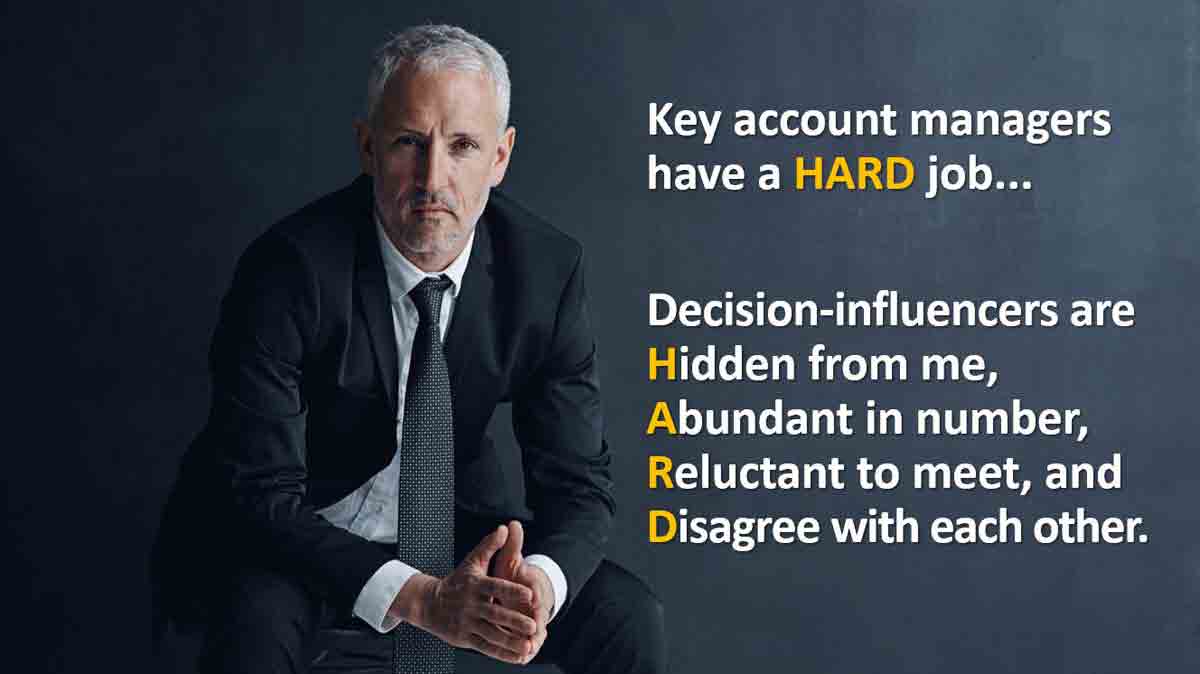
And that’s just part of the problem facing a key account manager. They have a HARD job because members of the buying team are…
- Hidden: The person that says “no” is often someone the key account manager hasn’t even met.
- Abundant: On average, 5.4 people are involved in B2B buying decisions. When buying teams have more than 5 members, their “intent to purchase” drops below 50%, compared to individual buyers at 81%.[2]
- Reluctant: Many of these decision-influencers are “too busy to meet with a salesperson.”
- Disagreeing: Because these decision-influencers hail from different job functions, they have very different perspectives on what is needed.
You overcome all these problems with Key Account Blueprinting. You meet with these decision-influencers in a series of three meetings that help them prioritize their needs and make effective decisions. You’re a facilitator bringing world-class tools to your customer’s decision-making: tools adapted from the world’s leading B2B voice-of-customer methodology.
You’re a facilitator bringing world-class tools to your customer’s decision-making.
Would Key Account Blueprinting work for you? Not if you have thousands of small customers, none of which is worth focusing on this intently. But if you have some large, important accounts, this can be a game-changer.
Here’s an interesting aside: Traditional New Product Blueprinting is seldom used by commodity producers, because it’s focused on developing innovative new products. But Key Account Blueprinting is effective for commodities. As my good friend Jim de Vries (EIG) showed me, it’s a powerful way to improve logistics support, invoicing, customer service, technical support… really anything important to the customer.
Let’s pull back the curtain and see five elements to implementing Key Account Blueprinting.
1. Help your key account uncover, prioritize, and decide
With traditional New Product Blueprinting, you run Discovery interviews to uncover all customer needs, Preference interviews to prioritize them, and Market Satisfaction Gap analysis to decide which to work on. For a demo, see the 5-minute video, Reinventing VOC for B2B.
You’ll run the same three meetings in Key Account Blueprinting, but here’s what’s different:
- You usually have just one Discovery meeting with your key account.
- You typically have just one Preference meeting with your key account.
- You analyze the Market Satisfaction Gap data with your key account, not just your own internal team.
Let’s look at what takes place in these three meetings. (For Key Account Blueprinting, you should call these sessions “meetings” instead of “interviews.”) They’re typically held on separate days, but it’s possible to accomplish all three in one full day.
Meeting 1, Discovery meeting: Most companies use Blueprinter software to record customer needs on sticky notes that the customer can see, using a web-conference or conference room screen. If your company makes paint ingredients and your key account is large paint producer, your notes might look like this:
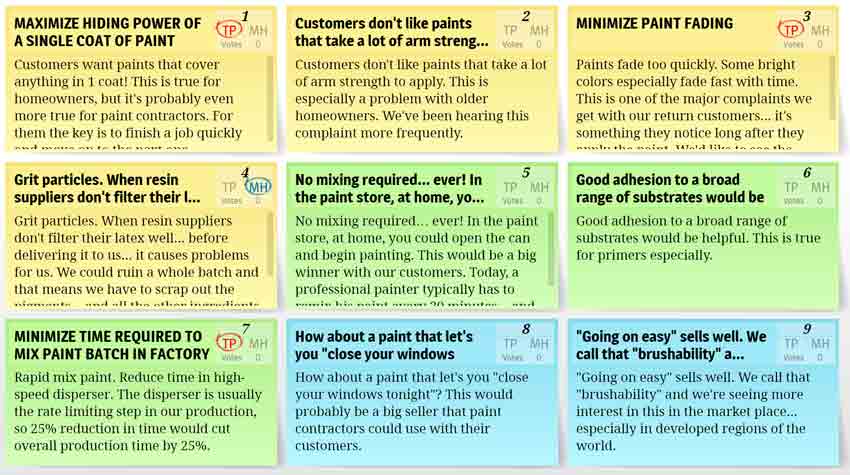
Meeting 2, Preference meeting: For each of 10-15 customer outcomes, you repeat two questions in this meeting:
- How important is (this outcome) to your company?
- How satisfied are you with your ability to (deliver this outcome) today?
As with the Discovery meeting, it’s best to let customers watch as you record their input. Here’s what this would look like using Blueprinter software:
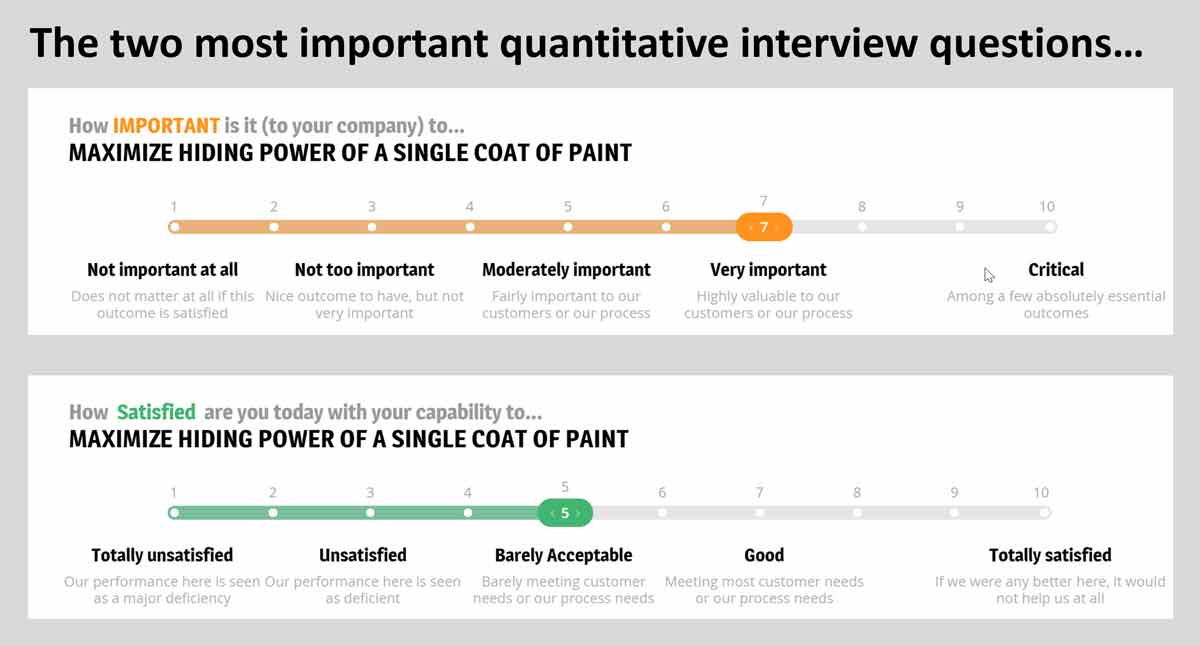
At the end of the session, you review their responses to see if the customer wants to a) make any rating adjustments, or b) add another outcome.
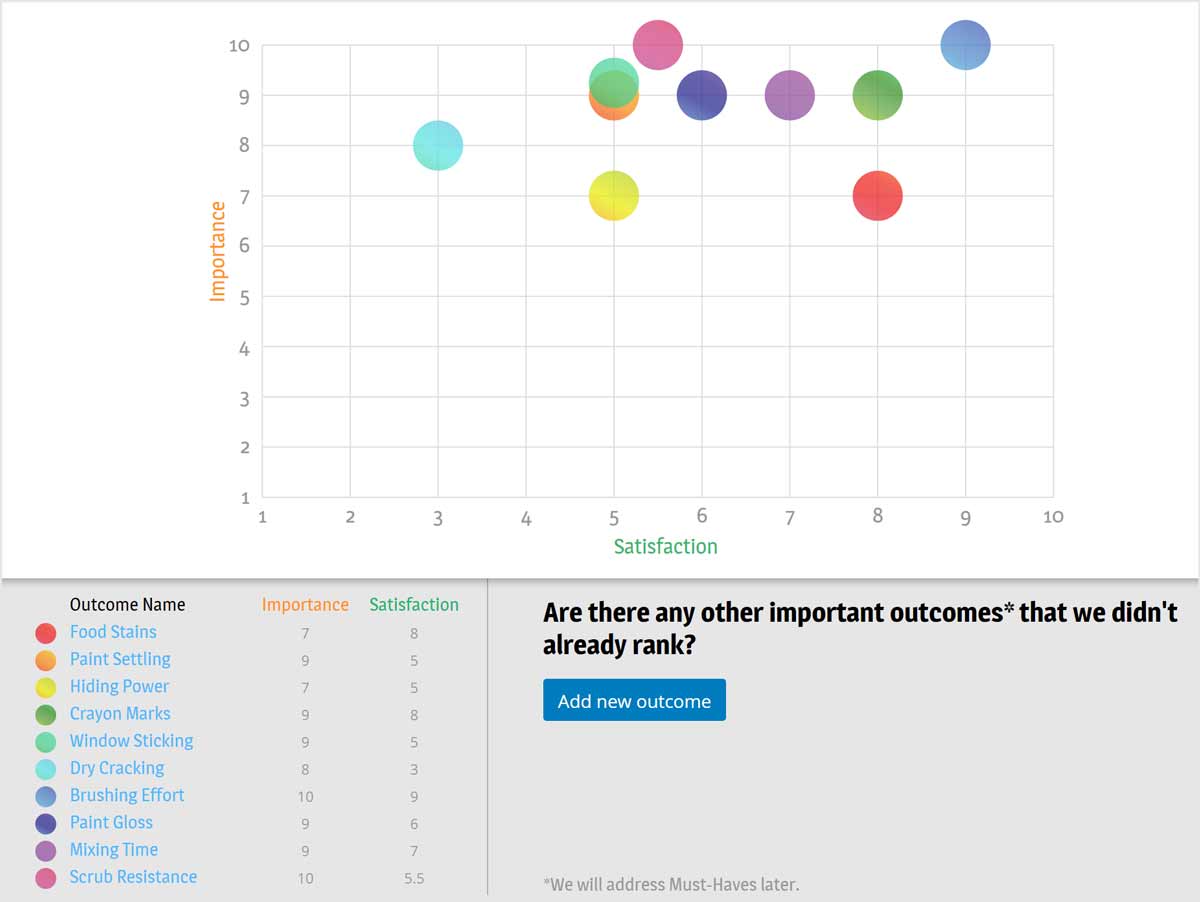
Meeting 3, Data analysis: Finally, you review the data from their Preference meeting, using advanced analytical tools—discussed below—that will impress your customer. Because this is all about meeting their needs—not an entire market—you’ll have excellent buy-in on the resulting execution plan. This is what they truly want you to work on.
2. Facilitate like a professional consultant
When companies employ Key Account Blueprinting, they demonstrate their expertise, much as a professional facilitator or consultant would. Here are some tips to facilitate like a pro:
A. Set your scope: Determine what the scope of this effort should be with your main customer contact(s). It could be ways to improve a) all your interactions with them (invoicing, logistics, service, etc.), b) their operational efficiency, c) just one of their products, or something else. The scope should be very important to them—so they’ll agree to these meetings—and something you can help them with.
B. Bring your top team: You should bring a multi-functional team. Consider which job functions should be represented by your key account and match them. When you bring your most respected and senior players, you’re more likely to attract the key account employees you want.
C. Use world-class probing skills: Use our What-Why-Clarify probing method, which is taught in New Product Blueprinting, Everyday VOC, and described in this 2-minute video: Build Your Interviewing Skills. Ask the customer for problems they want to see resolved. After probing each outcome (one per sticky note), ask, “What other problems do you have?” and continue with the next outcome. Since you have no idea what they’ll say next, this meeting is led by the customer, not you.
D. Add AI-generated problems: After the customer has generated all the outcomes they can think of, use your Blueprinter AI function to generate 20-to-40 problems typically faced in their application area. They may see problems they hadn’t thought of… and will appreciate your help. Here’s a partial list of AI-generated problems for interior paint.
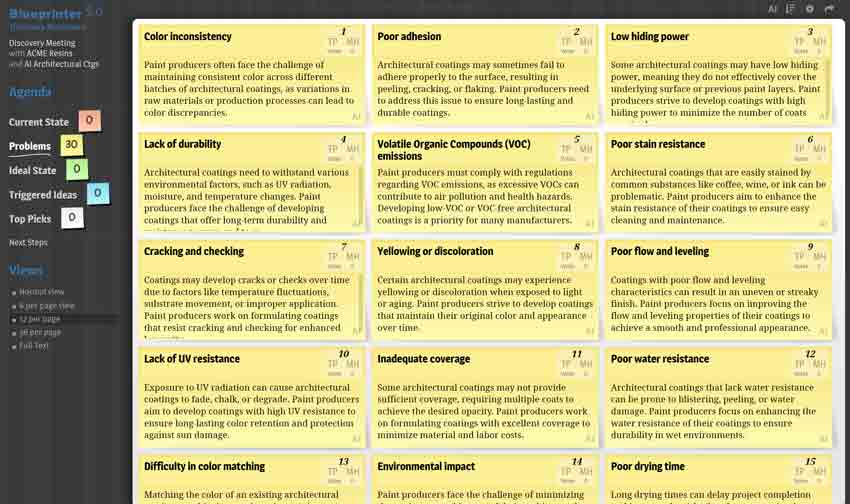
E. Use Trigger Maps: In Key Account Blueprinting, you should allow enough time to employ a Trigger Map. You prepare this beforehand and display it near the end of your Discovery meeting. The Trends Map, for instance, lists future trends that might affect your customer. Let them update your draft and then ask if these trends help them think of additional desired outcomes… which you record on sticky notes.
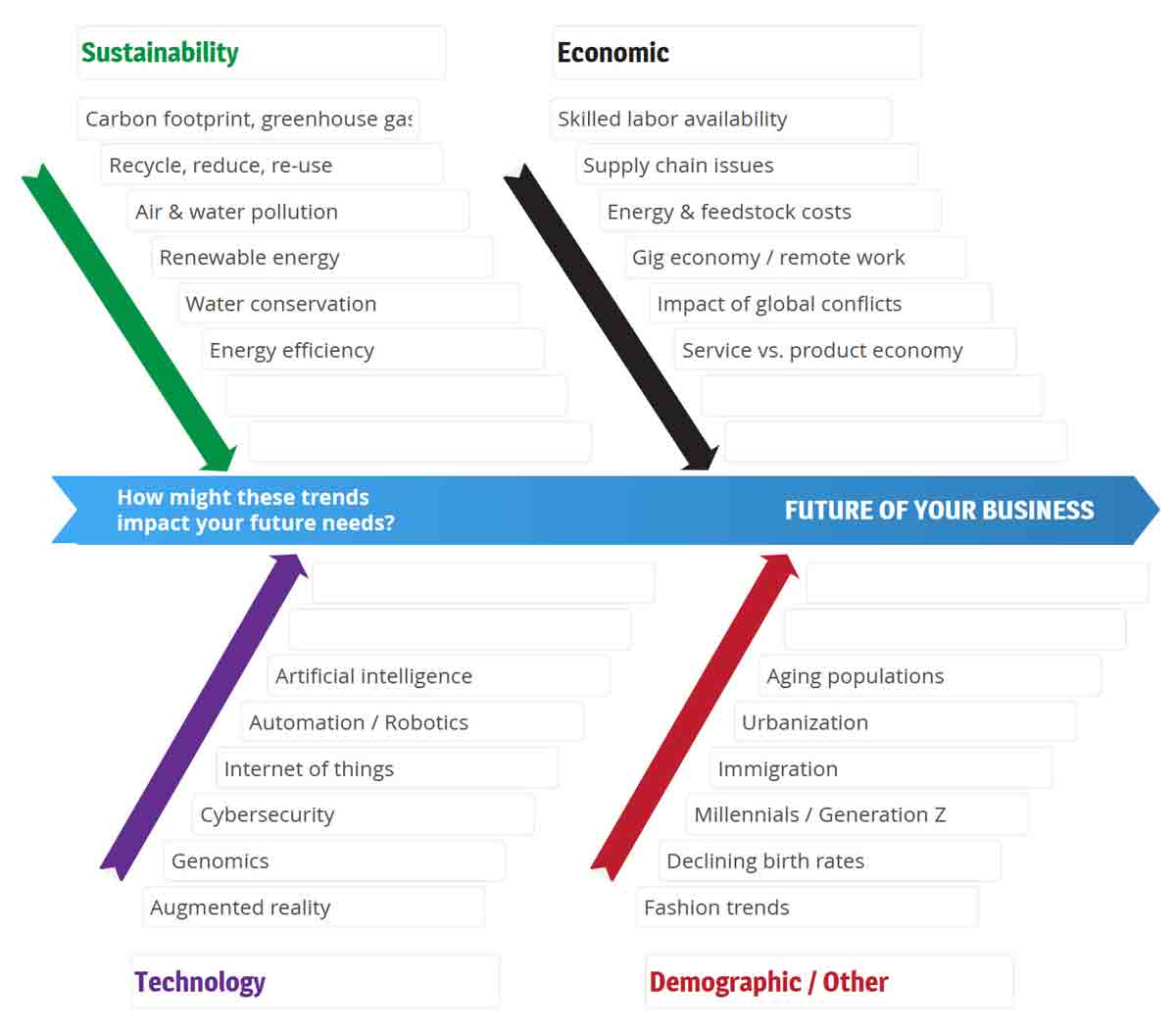
3. Analyze the results together
This is perhaps the biggest difference between Key Account Blueprinting and traditional New Product Blueprinting: Since all the input came from this customer, you should analyze the results together. Data analysis in Key Account Blueprinting impresses customers with your process savvy and facilitation skills.
Data analysis in Key Account Blueprinting impresses customers with your process savvy and facilitation skills.
First, show the Importance and Satisfaction results of the outcomes they rated during the Preference meeting. Your “bubble” chart might look like the one below. Your customer will be especially eager to improve outcomes in the upper-left… because they’re both important and currently unsatisfied.
Their 1-to-10 Preference ratings also create a Market Satisfaction Gap (MSG) chart as shown below. MSG is simply Importance times Dissatisfaction, where the latter is defined as 10 minus the Satisfaction rating. If paint Hiding Power has an Importance rating of 9 and a Satisfaction rating of 6, MSG = 10 x (10-6) = 36%.
Our work with over a thousand new-product teams around the world has shown that Gaps of 30% or more indicate high market eagerness for change. These are the only outcomes the customer might pay you a premium to improve. To see a dozen examples of Market Satisfaction Gap charts, see www.aimcasestudies.com.
4. Engage all customer decision-makers and -influencers
The Challenger Customer research showed many buying teams are diverse in their job functions, geographies, and objectives. And this buying team diversity can lead to buying team dysfunction. Specifically, the authors cite three types of dysfunctions: [3]
- Various stakeholders don’t have a fair say in group discussions.
- Stakeholders avoid discussions of the most important issues regarding a purchase altogether.
- Stakeholders outright disagree with one another, multiple times, regarding purchase details.
Buying team diversity can lead to buying team dysfunction.
This is where Key Account Blueprinting comes to the rescue. Imagine during your Preference meeting you ask for the 1-to-10 importance rating on something like “paint hiding power,” and the Production Manager says, “I’d only give it a 3… not very important.”
But the Marketing Director says, “Oh no, I’d give it a 9… almost critical… because paint contractors don’t want to come back for a second coat.” If they can’t resolve this on their own, simply ask, “How important is this from the perspective of your entire company?” It’s only when you facilitate this conversation with all the major decision-influencers that you can get an accurate view of what’s important to your key account.
The Preference meeting lets you replicate optimum customer decision-making… what they might have done under the very best conditions on their own. As a bonus, the customer recognizes that you—a supplier!—helped them make their business decisions. That’s how you leave competitors in the dust.
The Preference meeting lets you replicate optimum customer decision-making.
Here’s a variation on this theme: Imagine you make soda bottling equipment and your key account is Coca-Cola. In addition to meeting with the main decision-makers in Atlanta, you could offer to conduct a Preference survey of their many bottling plants. Now you can bring them data on what these facilities want improved… data they lack today. Again, you’re demonstrating that you’re a very different type of supplier.
5. Create a strong follow-up plan
If you do everything we’ve discussed so far—and then stop—you’ve failed at Key Account Blueprinting. Your third meeting—data analysis—is devoted to making decisions with the bubble chart and Market Satisfaction Gap charts… but also to creating an action plan.
It’s possible some of the high-MSG outcomes are outside your wheelhouse: They’re not something your company is able to help with. But if you’ve established a reasonable scope for your Key Account Blueprinting, it’s likely you can help with many of the high Market Satisfaction Gap outcomes.
After you get agreement from your customer on which outcomes to pursue, it’s time to develop this action plan. Assign owners and timelines on the actions for each outcome: Who does what when. With rigorous follow-up and timely updates, you’ll be seen as a rare kind of supplier they’re eager to do business with.
Summary…
This approach will help you with the macro-benefits of account retention, larger share of wallet, and higher pricing from higher value. But there are three important micro-benefits to Key Account Blueprinting as well:
- In the past, you might have “chased” the desires of a single customer contact, wasting time and resources on something no one else cared about. This problem goes away.
- Key Account Blueprinting creates the perfect “excuse” to have your contact invite elusive decision-influencers to your meetings. And you’ll not just meet these people: You’ll work together on the same team.
- Many key account managers struggle with “what to talk about” during their customer visits. Now you’ve got a clear action plan to monitor and update them on with each visit.
Key Account Blueprinting creates the perfect “excuse” to have your contact invite elusive decision-influencers to your meetings.
Next steps…
If you’re currently employing New Product Blueprinting, it’s a small step to also deploy Key Account Blueprinting. But perhaps your key account managers need to be brought up to speed. You can do this with New Product Blueprinting training, or our “lighter version” called Everyday VOC.
If you’re not familiar with New Product Blueprinting, check out these three 3-minute videos that quickly explain Blueprinting methods, training and software: http://www.NPBoverview.com, http://www.NPBtraining.com, and http://www.NPBsoftware.com. If you’d like a brief consultation, just Contact Us.
[1] Amazon book page description of The Challenger Customer.
[2] Brent Adamson, Matthew Dixon, Pat Spenner, and Nick Toman, The Challenger Customer (New York: Penguin Random House, 2015), 8.
[3] Ibid. p 19.
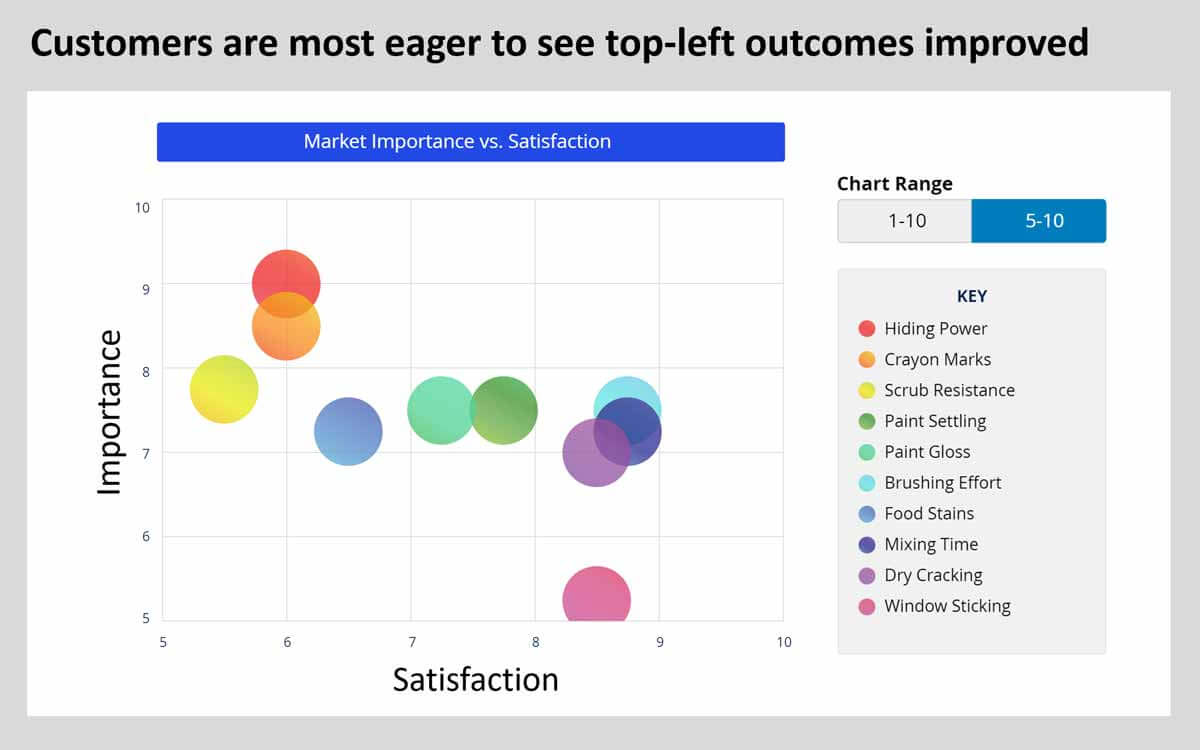
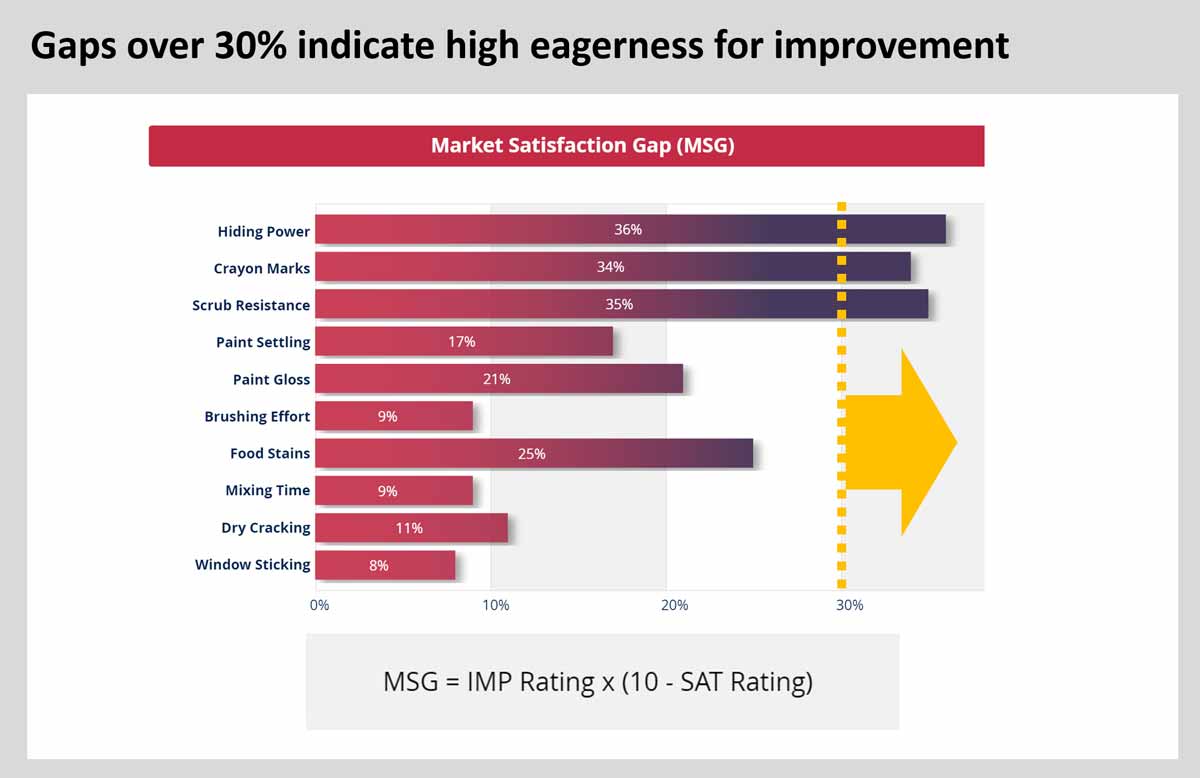
Comments